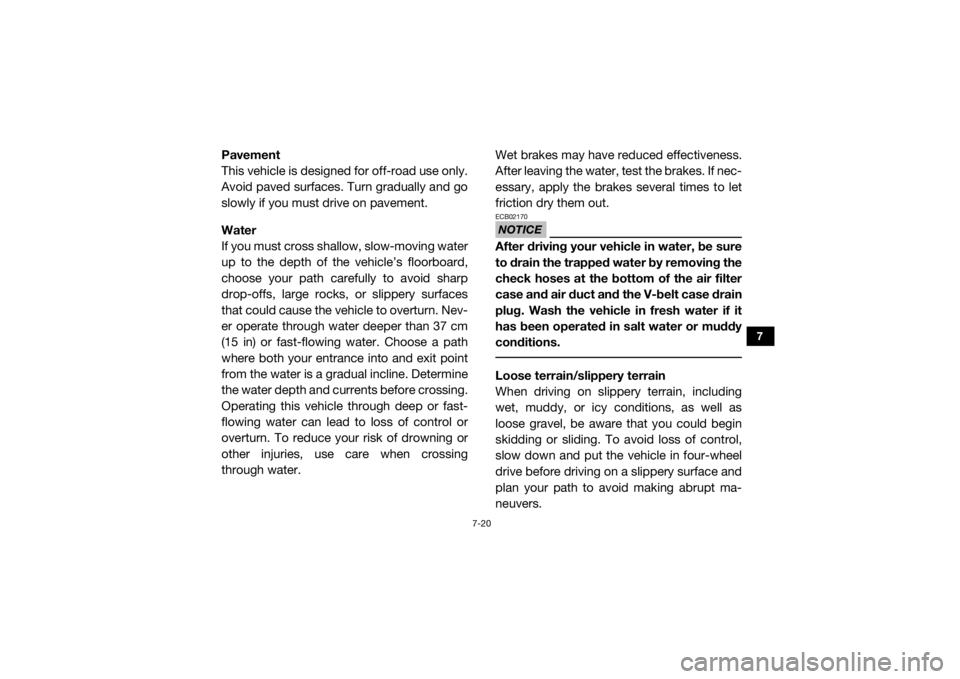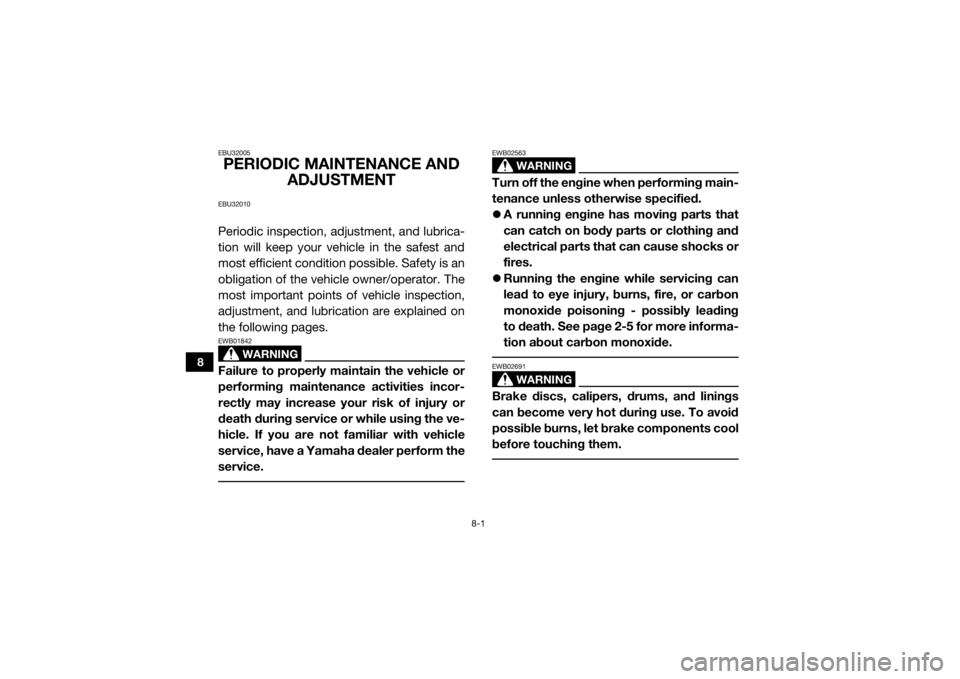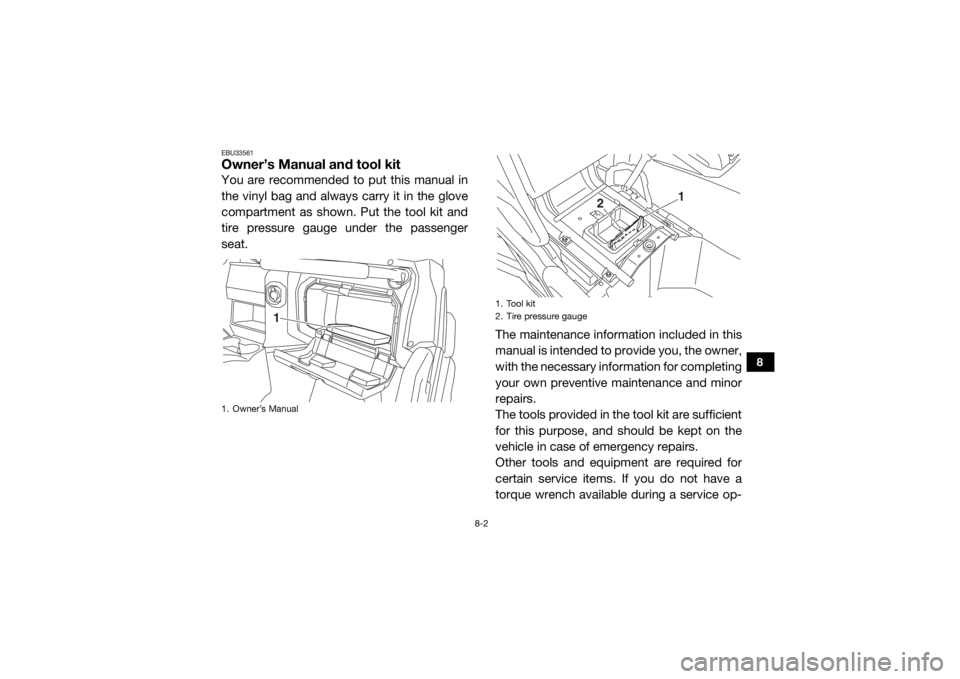YAMAHA WOLVERINE 2018 Owners Manual
Manufacturer: YAMAHA, Model Year: 2018, Model line: WOLVERINE, Model: YAMAHA WOLVERINE 2018Pages: 188, PDF Size: 5.4 MB
Page 111 of 188

7-20
7
Pavement
This vehicle is designed for off-road use only.
Avoid paved surfaces. Turn gradually and go
slowly if you must drive on pavement.
Water
If you must cross shallow, slow-moving water
up to the depth of the vehicle’s floorboard,
choose your path carefully to avoid sharp
drop-offs, large rocks, or slippery surfaces
that could cause the vehicle to overturn. Nev-
er operate through water deeper than 37 cm
(15 in) or fast-flowing water. Choose a path
where both your entrance into and exit point
from the water is a gradual incline. Determine
the water depth and currents before crossing.
Operating this vehicle through deep or fast-
flowing water can lead to loss of control or
overturn. To reduce your risk of drowning or
other injuries, use care when crossing
through water.Wet brakes may have reduced effectiveness.
After leaving the water, test the brakes. If nec-
essary, apply the brakes several times to let
friction dry them out.
NOTICEECB02170After driving your vehicle in water, be sure
to drain the trapped water by removing the
check hoses at the bottom of the air filter
case and air duct and the V-belt case drain
plug. Wash the vehicle in fresh water if it
has been operated in salt water or muddy
conditions. Loose terrain/slippery terrain
When driving on slippery terrain, including
wet, muddy, or icy conditions, as well as
loose gravel, be aware that you could begin
skidding or sliding. To avoid loss of control,
slow down and put the vehicle in four-wheel
drive before driving on a slippery surface and
plan your path to avoid making abrupt ma-
neuvers.
UB3D7AE0.book Page 20 Tuesday, November 7, 2017 9:38 AM
Page 112 of 188

7-21
7
If you feel the vehicle begin to slide sideways
or fishtail (rear-wheel sliding), steer into the di-
rection of the slide if possible, to regain direc-
tional control. For example, if you feel the
back of the vehicle start to slide to your right,
steer to the right.
Brush or wooded areas
When operating in areas with brush or trees,
watch carefully on both sides and above the
vehicle for obstacles such as branches that
the vehicle might hit, causing an accident.
Watch for brush that might enter the vehicle
as you pass and strike you or the passenger.
Never hold onto the cage/frame. The passen-
ger should always hold onto the passenger
handhold with both hands.
The muffler and other engine parts become
extremely hot during operation and remain
hot after the engine has stopped. To reduce
the risk of fire during operation or after leaving
the vehicle, do not let brush, grass and other
materials collect under the vehicle, near the muffler or exhaust pipe, or next to other hot
parts. Check under the vehicle after operating
in areas where combustible materials may
have collected. Do not idle or park the vehicle
in long dry grass or other dry ground cover.
Encountering obstacles
If you cannot go around an obstacle, such as
a fallen tree or a ditch, stop the vehicle where
it is safe to do so. Set the parking brake and
get out to inspect the area thoroughly. Look
from both your approach side and exit side. If
you believe you can continue safely, choose
the path that will allow you to get over the ob-
stacle and at as close to a right angle as pos-
sible to minimize vehicle tipping. Go only fast
enough to maintain your momentum but still
give yourself plenty of time to react to chang-
es in conditions.UB3D7AE0.book Page 21 Tuesday, November 7, 2017 9:38 AM
Page 113 of 188

7-22
7
If there is any question about your ability to
maneuver safely over the obstacle, you
should turn around if the ground is flat and
you have the room or back up until you find a
less difficult path.UB3D7AE0.book Page 22 Tuesday, November 7, 2017 9:38 AM
Page 114 of 188

8-1
8
EBU32005PERIODIC MAINTENANCE AND ADJUSTMENTEBU32010Periodic inspection, adjustment, and lubrica-
tion will keep your vehicle in the safest and
most efficient condition possible. Safety is an
obligation of the vehicle owner/operator. The
most important points of vehicle inspection,
adjustment, and lubrication are explained on
the following pages.
WARNING
EWB01842Failure to properly maintain the vehicle or
performing maintenance activities incor-
rectly may increase your risk of injury or
death during service or while using the ve-
hicle. If you are not familiar with vehicle
service, have a Yamaha dealer perform the
service.
WARNING
EWB02563Turn off the engine when performing main-
tenance unless otherwise specified.
A running engine has moving parts that
can catch on body parts or clothing and
electrical parts that can cause shocks or
fires.
Running the engine while servicing can
lead to eye injury, burns, fire, or carbon
monoxide poisoning - possibly leading
to death. See page 2-5 for more informa-
tion about carbon monoxide.
WARNING
EWB02691Brake discs, calipers, drums, and linings
can become very hot during use. To avoid
possible burns, let brake components cool
before touching them.
UB3D7AE0.book Page 1 Tuesday, November 7, 2017 9:38 AM
Page 115 of 188

8-2
8
EBU33561Owner’s Manual and tool kitYou are recommended to put this manual in
the vinyl bag and always carry it in the glove
compartment as shown. Put the tool kit and
tire pressure gauge under the passenger
seat.The maintenance information included in this
manual is intended to provide you, the owner,
with the necessary information for completing
your own preventive maintenance and minor
repairs.
The tools provided in the tool kit are sufficient
for this purpose, and should be kept on the
vehicle in case of emergency repairs.
Other tools and equipment are required for
certain service items. If you do not have a
torque wrench available during a service op-1. Owner’s Manual
1
1. Tool kit
2. Tire pressure gauge
1
2
UB3D7AE0.book Page 2 Tuesday, November 7, 2017 9:38 AM
Page 116 of 188

8-3
8
eration requiring one, take your vehicle to a
Yamaha dealer to check the torque settings
and adjust them as necessary.UB3D7AE0.book Page 3 Tuesday, November 7, 2017 9:38 AM
Page 117 of 188

8-4
8
EBU37180Maintenance chartsEven if the vehicle isn’t driven for the stated mileage or engine hours, the month maintenance
intervals should still be followed. Items marked with an asterisk should be performed by a
Yamaha dealer as they require special tools, data and technical skills.EBU32032Emission control systemNO. ITEM ROUTINE INITIAL
EVERY
Whichev- er comes first month 1 3 6 6 12
km
(mi) 320
(200) 1200
(750) 2400
(1500) 2400
(1500) 4800
(3000)
hours 20 75 150 150 300
1 *Fuel line • Check fuel hose for cracks or damage.
• Replace if necessary. √√√
2 *Va l v e s • Check valve clearance and adjust if neces-
sary. Every 2500 km (1600 mi) for the first
7500 km (4800 mi).
Every 5000 km (3200 mi) thereafter.
3 Spark plug • Check condition.
• Adjust gap and clean.
• Replace if necessary. √√√√√
4 *Breather system • Check breather hose for cracks or damage.
• Replace if necessary.
√√√
UB3D7AE0.book Page 4 Tuesday, November 7, 2017 9:38 AM
Page 118 of 188

8-5
8
5*Exhaust system • Check for leakage.
• Check for looseness and tighten all screw
clamps and joints if necessary.
• Replace gasket(s) if necessary. √√√
6 *Air induction sys-
tem • Check the air cut-off valve, reed valve, and
hose for damage.
• Replace any damaged parts if necessary. √√√√√
7 Spark arrester •Clean. √√√
NO. ITEM ROUTINE
INITIAL EVERY
Whichev- er comes first month136612
km
(mi) 320
(200) 1200
(750) 2400
(1500) 2400
(1500) 4800
(3000)
hours 20 75 150 150 300UB3D7AE0.book Page 5 Tuesday, November 7, 2017 9:38 AM
Page 119 of 188

8-6
8
EBU32114General maintenance and lubricationNO. ITEMROUTINE INITIAL
EVERY
Whichev- er comes first month 1 3 6 6 12
km
(mi) 320
(200) 1200
(750) 2400
(1500) 2400
(1500) 4800
(3000)
hours 20 75 150 150 300
1 *Cooling system • Check coolant leakage.
• Repair if necessary.
√√√√√
• Change coolant. Every 2 years
2 Air filter element •Clean.
• Replace if necessary. Every 20–40 hours (more often in
wet or dusty areas)
3Engine oil • Change (warm engine before draining). √√√√
4 Engine oil filter
cartridge • Replace.
√√√
5 Final gear oil • Check oil level.
√√√√√
• Change. √√
6 Differential gear
oil • Check oil level.
√√√√√
• Change. √√
7 *Front brake • Check operation/brake pad wear/fluid leak-
age.
• Correct if necessary. Replace pads if worn to the limit. √√√√√
UB3D7AE0.book Page 6 Tuesday, November 7, 2017 9:38 AM
Page 120 of 188

8-7
8
8*Rear brake • Check operation/brake pad wear/fluid leak-
age.
• Correct if necessary. Replace pads if worn to the limit. √√√√√
9 *Parking brake • Check operation and adjust if necessary. √√√√√
10 *Brake fluid • Change. Every 2 years
11 *Accelerator pedal • Check operation and free play. √√√√√
12 *V-b e l t • Check operation.
• Check for wear, cracks, or damage. √√
√
13 *Wheels • Check balance, runout and for damage.
• Replace if necessary. √ √√√
14 *Wheel bearings • Check bearing assemblies for loose-
ness/damage.
• Replace if damaged. √ √√√
15 *Front and rear
suspension • Check operation and for oil leakage.
• Correct if necessary.
√√
16 *Steering system • Check operation and for looseness. Replace
if damaged.
• Check toe-in. Adjust if necessary. √√√√√
NO. ITEM
ROUTINE INITIAL
EVERY
Whichev- er comes first month136612
km
(mi) 320
(200) 1200
(750) 2400
(1500) 2400
(1500) 4800
(3000)
hours 20 75 150 150 300UB3D7AE0.book Page 7 Tuesday, November 7, 2017 9:38 AM